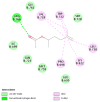In Silico Analysis of Bioactive Compounds from Leaves of Abrus precatorius L. (Rosary Pea) Against Breast Cancer
- PMID: 39323672
- PMCID: PMC11423556
- DOI: 10.7759/cureus.67808
In Silico Analysis of Bioactive Compounds from Leaves of Abrus precatorius L. (Rosary Pea) Against Breast Cancer
Abstract
Introduction Breast cancer is one of the most common causes of cancer among women. Since the administration of chemotherapy drugs can cause several adverse effects, thus it leads to research on effective treatment from natural sources. Leaves of Abrus precatorius L., a member of the Fabaceae family,contain several medicinal properties. It has drawn interest as an anti-cancer agent since its leaves contain different phytochemicals that can cause apoptosis in a variety of cancer types. Methods A total of 97 compounds were identified from the ethyl acetate extract of A. precatorius leaves by gas chromatography/mass spectrometry (GC/MS) analysis. Of those, eight compounds were selected based on the percentage area above 2. Cheminformatics software such as Molinspiration (Molinspiration Cheminformatics free web services, Slovensky Grob, Slovakia) was used to predict the molecular properties and bioactivity. PASS software (NCSS LLC, Kaysville, Utah, United States) was used to predict the scores of anticancer properties such as antioxidant, anti-inflammatory, immunosuppressant, antineoplastic, and cytoprotective. Osiris Property Explorer software was used to determine pharmacokinetic profile and toxicity prediction, and molecular docking was performed to determine the binding affinity towards the receptors. Results Out of eight compounds, one was selected based on the scores of the above software, then docking studies were done by using AutoDock Vina 4.2.6 (Center for Computational Structural Biology, La Jolla, California, United States). The results were compared with the reference compound, 5-fluorouracil, and 1,4-dimethyl-4 pentenyl acetate was identified as the most promising active compound found in this study. It shows better binding affinity towards the progesterone receptor (-6.0) when compared to the reference compound. Conclusion Based on the results, it has been proved that 1,4-dimethyl-4 pentenyl acetate may be used as an alternative for the management of breast cancer.
Keywords: 4-dimethyl-4 pentenyl acetate; abrus precatorius; breast cancer; her 2 receptors; molecular docking; molinspiration; osiris; pass software; progesterone receptor.
Copyright © 2024, Baskaran et al.
Conflict of interest statement
Human subjects: All authors have confirmed that this study did not involve human participants or tissue. Animal subjects: All authors have confirmed that this study did not involve animal subjects or tissue. Conflicts of interest: In compliance with the ICMJE uniform disclosure form, all authors declare the following: Payment/services info: All authors have declared that no financial support was received from any organization for the submitted work. Financial relationships: All authors have declared that they have no financial relationships at present or within the previous three years with any organizations that might have an interest in the submitted work. Other relationships: All authors have declared that there are no other relationships or activities that could appear to have influenced the submitted work.
Figures





Similar articles
-
The potential of Abrus precatorius leaves in arthritis alleviation computational approaches through lC-MS analysis.Future Sci OA. 2025 Dec;11(1):2483131. doi: 10.1080/20565623.2025.2483131. Epub 2025 Mar 25. Future Sci OA. 2025. PMID: 40131221 Free PMC article.
-
Chemical Characterization, In-silico Evaluation, and Molecular Docking Analysis of Antiproliferative Compounds Isolated from the Bark of Anthocephalus cadamba Miq.Anticancer Agents Med Chem. 2022;22(20):3416-3437. doi: 10.2174/1871520622666220204123348. Anticancer Agents Med Chem. 2022. PMID: 35125087
-
Computational investigation of phytochemicals from Abrus precatorius seeds as modulators of peroxisome proliferator-activated receptor gamma (PPARγ).J Biomol Struct Dyn. 2023 Jul-Aug;41(12):5568-5582. doi: 10.1080/07391102.2022.2091657. Epub 2022 Jun 30. J Biomol Struct Dyn. 2023. PMID: 35773777
-
The traditional uses, phytochemistry and pharmacology of Abrus precatorius L.: A comprehensive review.J Ethnopharmacol. 2022 Oct 5;296:115463. doi: 10.1016/j.jep.2022.115463. Epub 2022 Jun 14. J Ethnopharmacol. 2022. PMID: 35714881 Review.
-
Ethno botanical and Phytophrmacological potential of Abrus precatorius L.: A review.Asian Pac J Trop Biomed. 2014 May;4(Suppl 1):S27-34. doi: 10.12980/APJTB.4.2014C1069. Asian Pac J Trop Biomed. 2014. PMID: 25183095 Free PMC article. Review.
References
-
- Global cancer statistics 2022: the trends projection analysis . Chhikara BS, Parang K. https://pubs.thesciencein.org/journal/index.php/cbl/article/view/451 Chem Biol Lett. 2023;10:451.
-
- Abrus precatorius: a comprehensive insight into the phytochemical, pharmacological, therapeutic activities and safety. Aswin RK, Tridiganita IS, Arif NM, et al. J Drug Delivery Therapeut. 2022;12:151–157.
LinkOut - more resources
Full Text Sources
Research Materials
Miscellaneous
